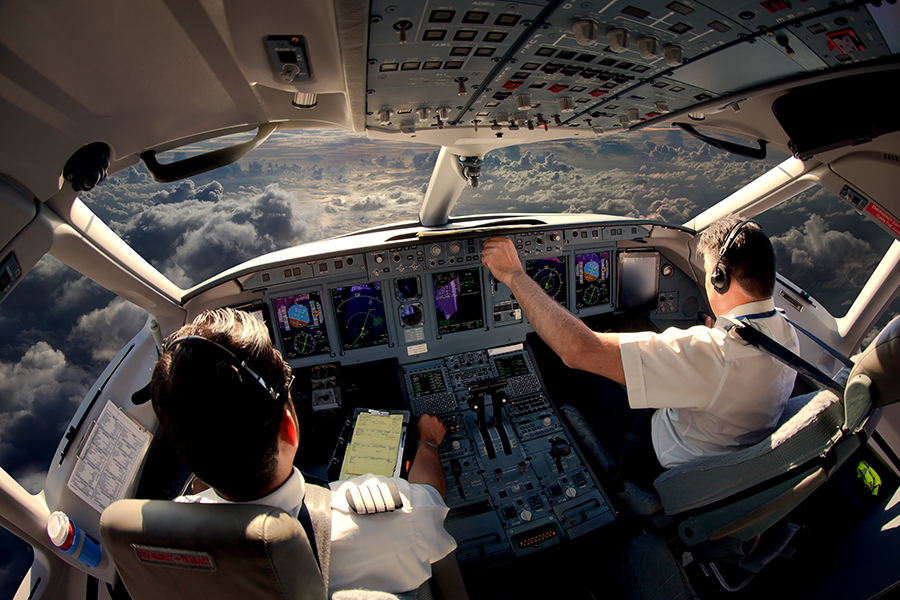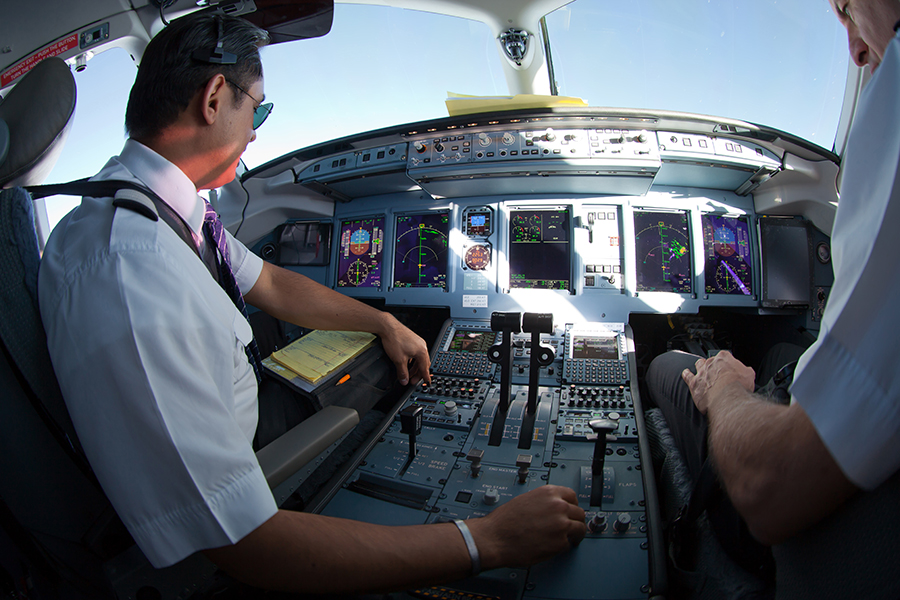-
True Course vs True Heading
-
What is the Difference Between True Course and True Heading?
- True Heading
- What Does True Course Mean?
-
The Difference Between True Course vs. True Heading
-
How Do I Calculate True Course
-
How Do I Calculate True Heading?
- Calculating Drift Angle and True Heading - Working Example
-
When Do We Use True Course and Heading?
-
Final Thoughts
Flying is most certainly unique as a form of transportation. What would you say if we told you that you don’t always go exactly in the direction you are pointing? It’s true! There is a very good reason for this, and it is important to understand the difference between true course vs.. true heading. Today we explain what true course is, along with true heading, and will demonstrate why it is so important when flying.
True Course vs True Heading
The true heading in the direction the aircraft nose is pointing referenced to true north. The true course is the aircraft path over the ground referenced to true north. The difference between the two results from a crosswind, which may require you to fly a different true heading to achieve your true course.
If the above sounds complex, don’t worry.
We will explain, in detail, what all of the above terms mean. And, by the end of this article, you’ll know everything about true course vs.. true heading.
Let’s get right to it.
What is the Difference Between True Course and True Heading?
The first terms we need to discuss, are the differences between course and heading.
It’s actually really simple.
True Heading

The heading is a basic term used in aviation all the time. It is a reference used to indicate where the aircraft’s nose is pointing. Normally it is given in degrees magnetic, but it is easy to convert it back to true heading.
We can achieve this using a few aircraft instruments: –
- The Compass – This instrument always points north and is divided into segments of 360°. It is further subdivided into cardinal points. North, East, South, and West.
- The Heading Indicator – This instrument is more accurate and stable than the compass. It has the same scale of degrees and cardinal points.
It is important to note that both reference magnetic north and not true north. We fly a magnetic heading using these instruments.
Wait, what’s magnetic heading?
Magnetic heading is the true heading with a correction applied for variation. Variation is the difference between true north and magnetic north. You can read more about it here.
All you need to know about heading (regardless of whether it is true or magnetic) is that it is a term used to describe where the aircraft’s nose points. It really is that simple.
So, my heading is my course, right?
Nope, not always.
Here’s why true course vs.. true heading are different…
What Does True Course Mean?
In the simplest terms, the course of an airplane is the line it draws over the ground as it flies from one point to another. When we measure the angle of this line against the true north, we can calculate a resulting true course.
Think of the true course as a line on a map.
Easy, right?
In an ideal world (and with some excellent handling skills), we as pilots aim to make the aircraft track accurately over this line.
However, there is something that often prevents us from doing this.
The wind.
There is nearly always wind aloft, and it often intersects the aircraft’s path from one side or another. This introduces a crosswind component.
Here’s a simple explanation of the effects of wind when calculating true course vs.. true heading…
The Difference Between True Course vs. True Heading
The only difference between true course vs. true heading comes from the wind. The difference depends on a couple of factors. First, how strong the wind is. And second the angular difference between the true course and the direction of the wind.
To break it down in simple terms, remember these two rules: –
- The greater the angular difference between the true course and the wind (up to a maximum of 90°), the greater the difference between a true course and a true heading.
- The greater the wind speed, the greater the difference between a true course and a true heading.
If you want a practical and easy-to-understand example, here it is.
Imagine standing on one side of a river, and you want to get a boat across to a fixed point on the other side. The straight line from one point on one bank to the other is your course.
However…
The river has a current that is flowing. Suppose you simply aim the boat at the opposite point (I.E matching your heading to your course). In that case, you will be washed downstream as you make your way across, so you’ll miss your target point on the opposite bank.
The way around this is to apply a correction, aiming the nose of the boat upstream to counter the effects of the current.
You can transpose the above to airplanes too. Except, in place of a flowing river, we have a crosswind pushing us from the side as we make our way from point A to B. The line between points A and B is our course. The direction we fly, correcting for the effect of the crosswind, is our heading.
Get it?
How Do I Calculate True Course
The true course is easy to calculate. We normally do it on an aviation chart.
To calculate the true course, follow these simple steps: –
- On a map, and using a straight ruler, select two points and draw a line between them
- Using a protractor or navigational plotter, align north with one of the longitudinal lines pointing to true north on the map.
- Measure the angle of the line you have drawn with reference to true north. The resulting number is your true course.
How Do I Calculate True Heading?

There is an easy-to-remember formula for calculating true heading. The difference between a true course and a true heading is called the drift angle. So armed with this information, we can deduce the following: –
- True Heading = (True Course) +/- (Drift Angle)
As pilots, we like to work on worst-case scenarios. So, what we do is calculate something called maximum drift. And from there, work backward to work out our drift angle. You’ll find out how to calculate the drift angle below.
The true heading is slightly more complicated.
As the above equation demonstrates, it is corrected for wind, which, obviously, varies from day to day and hour to hour. However, it can be done. You’ll need four key pieces of information: –
- The true course (as calculated above).
- The direction of the prevailing wind aloft
- The strength of the prevailing wind aloft
- The speed of the aircraft
Wait, why do we need the aircraft speed?
Simple.
The faster the aircraft flies, the less effect the crosswind has as the airplane makes its way from point A to B. Going back to our boat and river analogy, which would be more affected by the current, a fast-moving speedboat or a slow rowing boat?
Remember how we said that the stronger the wind and the greater the angular difference from our course, the greater its effect?
There’s an easy way to work it out using a little math.
It requires a basic knowledge of trigonometry, but we will make it easy for you.
Check out the table below to see how the effects of crosswind vary depending on its angular difference from your true course.
| Difference Between Wind Direction and True Course | Sine of Angular Difference |
| 10° | .17 |
| 20° | .34 |
| 30° | .50 |
| 50° | .76 |
| 60° | .86 |
| 70° | .93 |
| 80° | .98 |
| 90° | 1 |
If the above numbers look complex, don’t worry.
Think of the numbers in the right column in terms of percentages as to how much of a correction you’ll need to apply to ensure you can fly an accurate, true course.
If the wind is only 10° different from our required course, it will only have a small effect. However, if it comes from 90° on either side of the aircraft, there will be a larger difference between our true course vs. true heading.
So, back to our equation. Let’s jog your memory. Remember?: –
- True Heading = (True Course) +/- (Drift Angle)
We already know our true course, and we want to work out our true heading. So, in theory, all we need to do is work out our drift angle. The drift angle will vary based on where the wind is coming from. This will obviously change as we turn and maneuver the aircraft.
Here’s a practical step by step example of how to calculate both maximum drifts and drift angle using the above table: –
Calculating Drift Angle and True Heading – Working Example
- Aircraft Speed: 120 knots
- True Course: 010°
- Wind Direction: 060°
- Wind Speed: 30 knots
- First, we work out our maximum drift. We look at the difference between the true course and the wind direction, our airspeed, and the wind speed. Start by dividing 60 by your airspeed. In this case, that comes out as 0.5. Multiply the windspeed by this number. 30 knots multiplied by 0.5… The answer is 15°. So, 15° is our maximum drift.
- Now we know the maximum drift, it is easy to apply a correction to true course vs. true heading. Simply work out the difference between your true course and the wind direction. Using the above numbers in our example, the difference is 50°.
- Reference the above chart. Notice that the difference between a true course and wind direction corresponds to sine of 0.76? So we multiply our maximum drift by 0.76 to give the drift angle.
- 15° x 0.76 = 11.4°
- We now know our drift angle is 11.4°, and the wind is from the right, meaning we’ll need to turn right to offset its effects. So, armed with the above, we can deduce the following when it comes to true course vs. true heading: –
- Our true course is 010°
- Remember, True Heading = (True Course) +/- (Drift Angle)
- So True heading = 010° + 11.4°
- Our true heading using the above example would be 21.4°
Here’s a quick step by step guide to calculating drift angle without the numbers: –
- Divide 60 by your airspeed, then multiply the result with the wind speed to work out max drift
- Calculate the angular difference between your true course and wind direction, and work out the sine of this angle (to the nearest 10°)
- Multiply max drift by the result from step 2. This is your drift angle (also called ‘single drift’)
- Add or subtract the single drift to your true course to work out the true heading
When Do We Use True Course and Heading?

The truth is that pilots only refer to the true course and true heading during the planning stages of a flight. None of the instruments onboard references either true course or true heading. Instead, they reference magnetic headings and bearings.
You’ll apply a further connection to true course and heading to give you a magnetic course to steer during the planning stage. This will be what you use in your navigational flight plan.
First, we must work out everything in degrees true before adding or subtracting magnetic variation. Knowing how to work out true course, true heading, and understanding the difference is so important.
Wait, what’s the magnetic variation?
This is simply the angular difference between the geographic north pole (at the ‘top’ of the globe) and where your compass points (a point at the top of Northern Canada). You can find the magnetic variation on most aviation charts.
Final Thoughts
True course and true heading both have a useful application. Still, they are normally only used in the planning stages of the flight. You’ll use magnetic bearings when actually navigating in the aircraft. When navigating between two points, true course vs. true heading is different because of the crosswind component. Want to know how to do that in an aircraft?
We have free courses that will serve as a great introduction to getting familiar with how to fly an aircraft. And it’s all online! Why not check these out before you leave?




